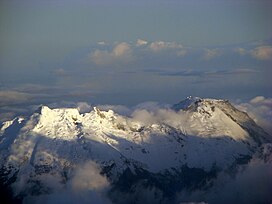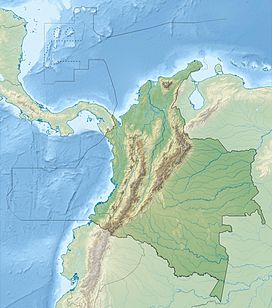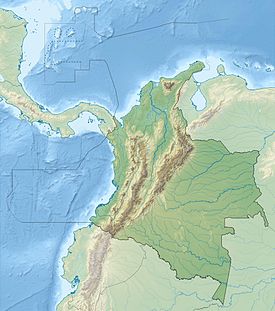| Nevado del Huila | |
|---|---|
 Nevado del Huila in December 2008 | |
| Highest point | |
| Elevation | 5,364 m (17,598 ft) |
| Prominence | 2,650 m (8,690 ft) |
| Listing | Ultra |
| Coordinates | 02°55′48″N 76°01′48″W / 2.93000°N 76.03000°W |
| Geography | |
| Location | Cauca, Huila & Tolima |
| Parent range | Central Ranges Andes |
| Geology | |
| Mountain type | Andesitic stratovolcano |
| Volcanic arc/belt | North Volcanic Zone Andean Volcanic Belt |
| Last eruption | 2008 to 2012 |
Nevado del Huila (/nɛˈvɑːdoʊ dɛl ˈwiːlə/, Spanish pronunciation: [neˈβaðo ðel ˈwila]) at 5,364 metres (17,598 ft),[1] is the highest volcano in Colombia, located at the tripoint of the departments of Huila, Tolima and Cauca. It is visible from the city of Cali.[2] The andesitic volcano is located on top of the Ibagué Batholith.[3]
After being dormant for more than 500 years, the volcano showed heavy signs of activity in 2007 and 2008. As of February 20, 2007, there were more than 7000 "minor" seismic events, and a high state of alert was in place for the departments of Cauca, Huila, Caldas and Valle del Cauca.[4] The volcano erupted twice in April 2007, once in April 2008 and again in November 2008. Any eruption would affect the small villages around the volcano, mostly Páez, where their inhabitants still have in memory the eruption of the Nevado del Ruiz volcano and the destruction of Armero.
- ^ "Global Volcanism Program | Nevado del Huila". volcano.si.edu. Retrieved 2018-07-20.
- ^ yoxPaz, Manuel María. "View of Cali and of the Snow-Capped Mount Huila, Province of Buenaventura". World Digital Library. Retrieved 2014-05-22.
- ^ Plancha 322, 1999
- ^ "Reducción de actividad sísmica de Nevado del Huila aligera estado de emergencia en zonas cercanas". El Tiempo (in Spanish). February 20, 2007. Retrieved February 20, 2007.

